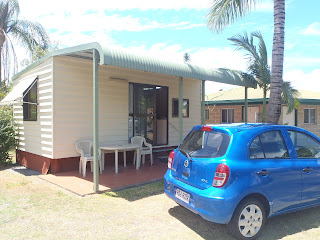From Rainbow Beach, we thought we'd head just a bit further north and check out Hervey Bay. We took the back way, though hundreds of square kilometres of weirdly out-of-place pine tree farms. (European style grids of manicured pine trees where Eucalypti would normally be.) Apparently a very valuable industry in Australia, but a different take on the forest industry than BC's more natural replanting and growth.
On the way to Hervey Bay, we passed through Maryborough, birthplace of PL Travers, the author of Mary Poppins.
As luck would have it, there was a homebrew shop on the main street. I might talk about that a bit in an upcoming hoplog blog post.
Maryborough has a lot of nice architecture for a small town. Back in the day it was competing to be the main rail terminus for the region. It lost, but the buildings remain.
Hervey Bay was bigger than we expected, and seemed to be another beach vacation town much along the lines of the many we had already visited. So during our overnight stay we didn't get beyond our caravan park very much. We thought we'd see how the Aussies do urban trailer/RV camping - we rented a cabin in a very nice caravan park, and where we got to go for a swim, make tropical fruit salad and cook fajitas.
Our cabin and our trusty right-hand-steered Nissan Micra.
Home sweet (and very warm) home.
Here's a pretty typical Aussie camping setup. It looks like a utility trailer, and can be pulled by almost any car, yet folds out into a huge family-sized multi-room tent. Most Aussies seem to have either huge & elaborate tent and sunshade setups, or a tent trailer or similarly small travel trailer. You don't see anyone pulling a massive 39-foot fifth-wheel RV with a one-tonne diesel truck, or a huge converted tour bus motorhome, or any such similarly ridiculous setups that pollute the summertime roads in Canada and the USA - and thank goodness for that! Camping is more like camping and less like living at home for most people. As to why there aren't huge RV rigs here, I don't know. Gas prices aren't too much higher than Canada. But outside of the coastal areas there are many narrow, windy and/or unsurfaced roads, unsuitable to the "moveable house" people. And maybe you have to register such monster vehicles as commercial transportation or something in Australia. At any rate, it's nice to see people enjoying the outdoors instead of the insides of their 800 square foot air-conditioned, satellite-TVed homes on wheels that so many people own in North America. (I don't want to go off on a rant here (a bit late for that I guess), but you can't complain about fuel prices if you purchase an RV setup that weighs 20,000 pounds! I'm looking at you, Albertans and Arizona snowbirds...)
But I digress. The next day we swung down another scenic tourist road that follows a ridge south, several kilometres inland from but within sight of the coast.
This is a semi-famous waterfall national park area we stopped at. Actually, we went out of our way to see it. You'll notice no water is visible. Next, please!
We arrived at the glasshouse mountains next. It's a region first mentioned by Captain Cook in his logs (like most things on the east coast of Australia) - the cores of volcanoes whose softer shoulder rock has eroded, leaving towers behind. Much like Black Tusk in BC.
The mountains themselves are little islands of National Park. But note how the tree colour changes at the base of the mountains. That's because they're poking out of a sea of privately-run pine tree farm again. Definitely a different look from Captain Cook's day.
We drove down through the pine tree farms and past the Australia Zoo, developed by the world-famous Steve Irwin (a.k.a. The Crocodile Hunter). It was getting late in the day so we didn't actually stop in, though we understand it's a great zoo.
Besides, we had to get to Brisbane and get ready for our down-under Christmas!















No comments:
Post a Comment